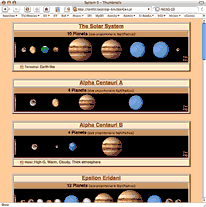Am I supposed to write "Aspirin" at the head of each of my 'technical' posts?
I will add that, due to my extremely slow typing rates, my original (handwritten) version was twice that length, and contained references to "Fleet of Worlds" (Larry Niven; Klemperer rosette of habitable planets with artificial satelighting), "Ringworld" and "the Smoke ring" from the same author, "Rocheworld" from R.L. Forward and "Red/blue/Green Mars" from Kim Stanley Robinson (All of which are worth checking out)
I personally suspect that the poverty of immediately viable habitats combined with the years of city living, almost divorced from nature (and the decades of early space exploration where totally synthetic environments will be essential) will leave us less impatient to walk naked on a planet's surface; it's even possible that our cities will have to experiment with becoming self contained biotopes on Earth before your scenario comes to bloom.
I can't see a decent terraforming in less than a thousand years or so; and, if the place requires little work, that indicated it already has an ecology (most of the conditions for life are produced by life); do we have the moral right to wipe this out and replace it with one better adapted to out needs (or, from the species that has introduced rats, mongooses and cane toads to regions where they had no natural control, the wisdom to do it right)?
Still, a synthetic environment can't support a regressed society for long (there have been a lot of books about this), and a feedback stabilised ecology is a much safer long term bet, so if we can convert planets with reducing atmospheres to our needs, so naked savages can run around without worrying where their next lungfull of air is coming from, it behoves us to do so.
An interstellar empire is dependent on times to planet hop, masses transportable, and the economics of the transport. Your ships travel very fast, (intergalactic in days? That's ridiculously fast. Or perhaps they don't travel, in the sense of being at points between A and B at all) but I don't know their capabilities. In early days you wouldn't need an empire, anyway; economic forces would suffice. By the time a few colonies had claimed their independence, it'd probably be too late for the authorities to clamp down; though, being politicians, they'd probably try. Only a devastating technical innovation could then make reconquest a viable option.
You've obviously got an 'ansible' instantaneous communications system; that helps maintain authority over great distances, but is not, in itself, enough. It's existence tells us that we are not in an Einstinnian universe, nor even one where we can be certain 'distance' has a real meaning.

I'm looking up references of 'maximum number of planets', although perhaps 'maximum number of terraformable bodies' might be better (a hot gas giant might have any number of moons falling in the liquid water zone) or 'the number of places in which DNA based organisms might be able to find a niche'.


